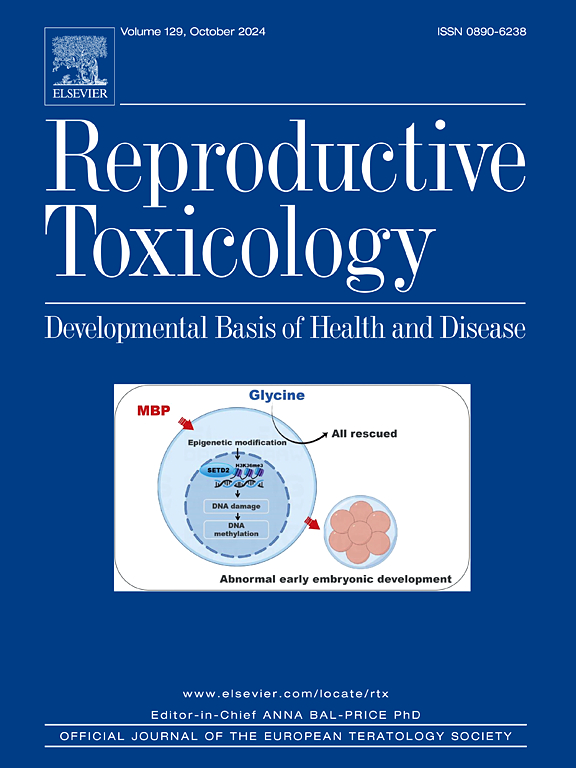Zebrafish embryos as a teratogenicity screening tool to reduce potential birth defects
IF 3.3
4区 医学
Q2 REPRODUCTIVE BIOLOGY
引用次数: 0
Abstract
Teratogens play a crucial role in the development of birth defects, making effective screening vital for prevention and management. This study aimed to develop an optimized zebrafish embryo-based platform for teratogenicity screening and further evaluate its findings with established clinical and animal data. Zebrafish embryos [6–8 h post-fertilization (hpf)] were exposed to 19 different test solutions, including nine known teratogens and ten non-teratogens, in 96-well plates, and mortality and morphological abnormalities were assessed at 48, 72, and 96 hpf. The half-lethal concentration (LC50) and half-effective concentration (EC50) were calculated from the counts of dead and abnormal embryos, respectively. The teratogenicity index (TI), defined as LC50/EC50, was used to classify the chemicals. Of the tested compounds, eight were identified as teratogenic, nine as non-teratogenic, and two outliers due to solubility constraints in this assessment. Notably, extending the exposure duration to 96 hpf provided a more accurate assessment of teratogenicity compared to shorter exposures. Eight teratogenic substances exhibited a TI greater than 3, while (-)-thalidomide did not yield a definitive TI due to low solubility. Among the non-teratogenic chemicals, nine had a TI below 3, with ajmaline also lacking a precise TI due to solubility constraints. These findings suggest that using a 6–8 hpf to 96 hpf exposure window and establishing a TI threshold of 3 can facilitate reliable teratogenicity risk assessment. Furthermore, the phenotypes observed in zebrafish embryos were consistent with typical teratogenic malformations documented in clinical and animal studies. This study demonstrates that the refined zebrafish embryo teratogenicity testing method coupled with the TI, can be an effective tool for assessing teratogenic risk.
斑马鱼胚胎的致畸性筛选工具,以减少潜在的出生缺陷。
致畸物在出生缺陷的发展中起着至关重要的作用,因此有效的筛查对预防和管理至关重要。本研究旨在开发一个优化的斑马鱼胚胎致畸筛查平台,并通过已建立的临床和动物数据进一步评估其发现。将斑马鱼胚胎[受精后6-8小时(hpf)]置于96孔板中,暴露于19种不同的测试溶液中,包括9种已知致畸剂和10种非致畸剂,并评估48、72和96 hpf时的死亡率和形态学异常。以死亡胚数和异常胚数分别计算半致死浓度(LC50)和半有效浓度(EC50)。致畸性指数(TI)定义为LC50 / EC50,用于对化学品进行分类。在测试的化合物中,8种被确定为致畸,9种被确定为非致畸,2种因溶解度限制而异常。值得注意的是,与较短的暴露时间相比,将暴露时间延长至96 hpf可以更准确地评估致畸性。8种致畸物质表现出大于3的TI,而(-)-沙利度胺由于溶解度低而不能产生明确的TI。在非致畸化学物质中,有9种的TI低于3,由于溶解度的限制,ajmaline也缺乏精确的TI。这些结果表明,使用6-8 hpf至96 hpf的暴露窗口和建立3的TI阈值可以促进可靠的致畸风险评估。此外,在斑马鱼胚胎中观察到的表型与临床和动物研究中记录的典型致畸畸形一致。本研究表明,结合TI的精细斑马鱼胚胎致畸性检测方法,可作为评估致畸风险的有效工具。
本文章由计算机程序翻译,如有差异,请以英文原文为准。
求助全文
约1分钟内获得全文
求助全文
来源期刊

Reproductive toxicology
生物-毒理学
CiteScore
6.50
自引率
3.00%
发文量
131
审稿时长
45 days
期刊介绍:
Drawing from a large number of disciplines, Reproductive Toxicology publishes timely, original research on the influence of chemical and physical agents on reproduction. Written by and for obstetricians, pediatricians, embryologists, teratologists, geneticists, toxicologists, andrologists, and others interested in detecting potential reproductive hazards, the journal is a forum for communication among researchers and practitioners. Articles focus on the application of in vitro, animal and clinical research to the practice of clinical medicine.
All aspects of reproduction are within the scope of Reproductive Toxicology, including the formation and maturation of male and female gametes, sexual function, the events surrounding the fusion of gametes and the development of the fertilized ovum, nourishment and transport of the conceptus within the genital tract, implantation, embryogenesis, intrauterine growth, placentation and placental function, parturition, lactation and neonatal survival. Adverse reproductive effects in males will be considered as significant as adverse effects occurring in females. To provide a balanced presentation of approaches, equal emphasis will be given to clinical and animal or in vitro work. Typical end points that will be studied by contributors include infertility, sexual dysfunction, spontaneous abortion, malformations, abnormal histogenesis, stillbirth, intrauterine growth retardation, prematurity, behavioral abnormalities, and perinatal mortality.
 求助内容:
求助内容: 应助结果提醒方式:
应助结果提醒方式:


